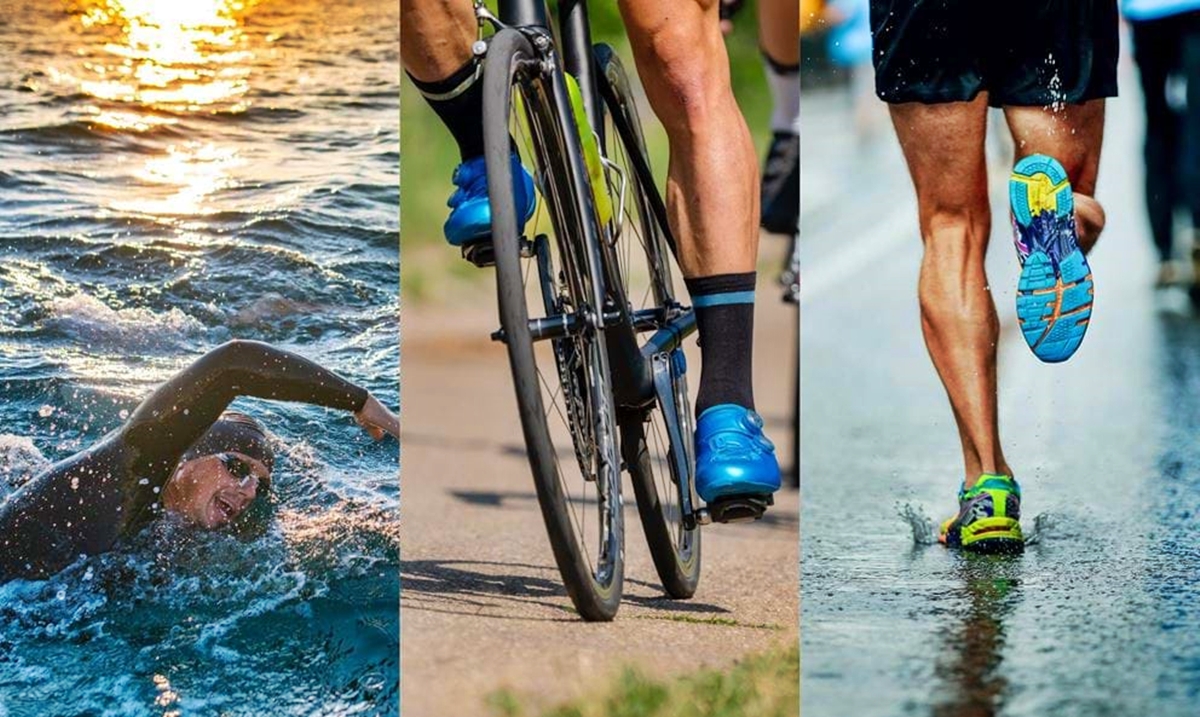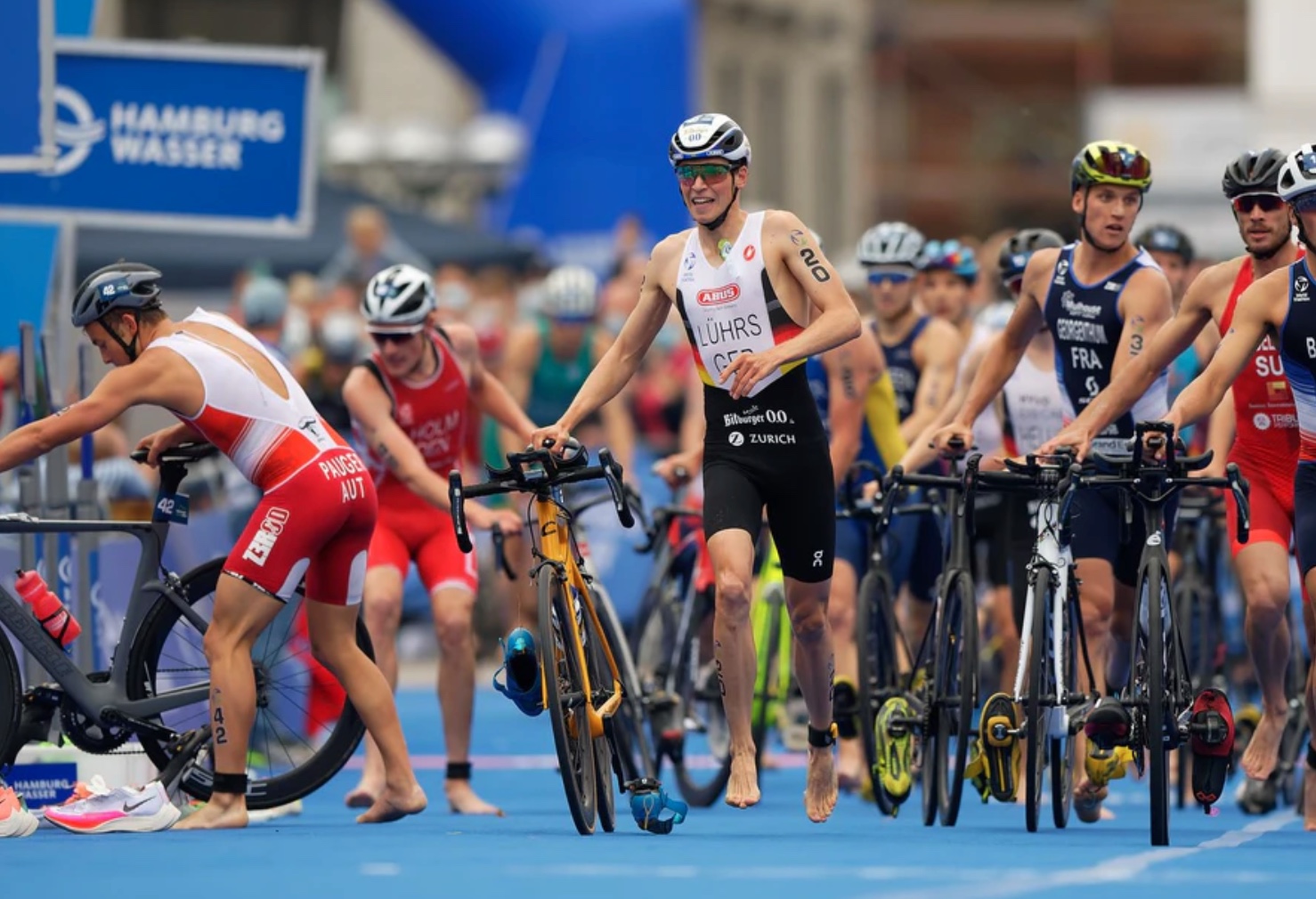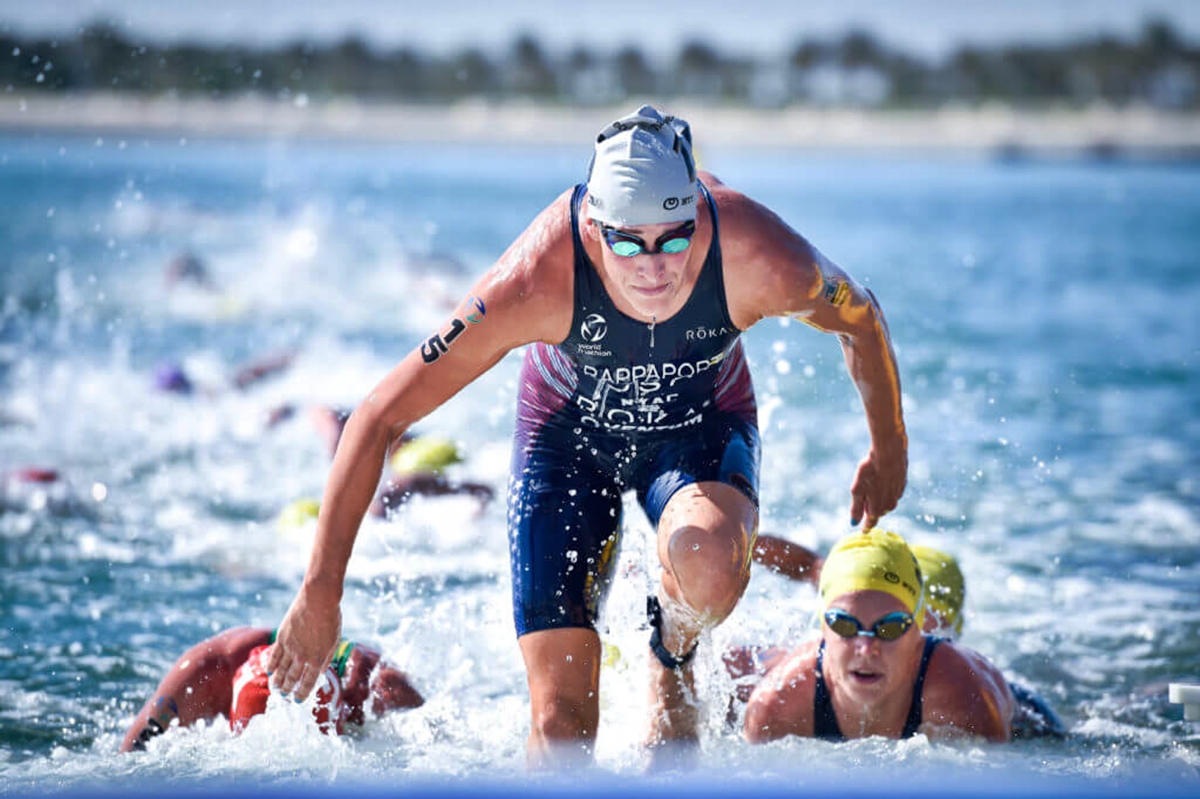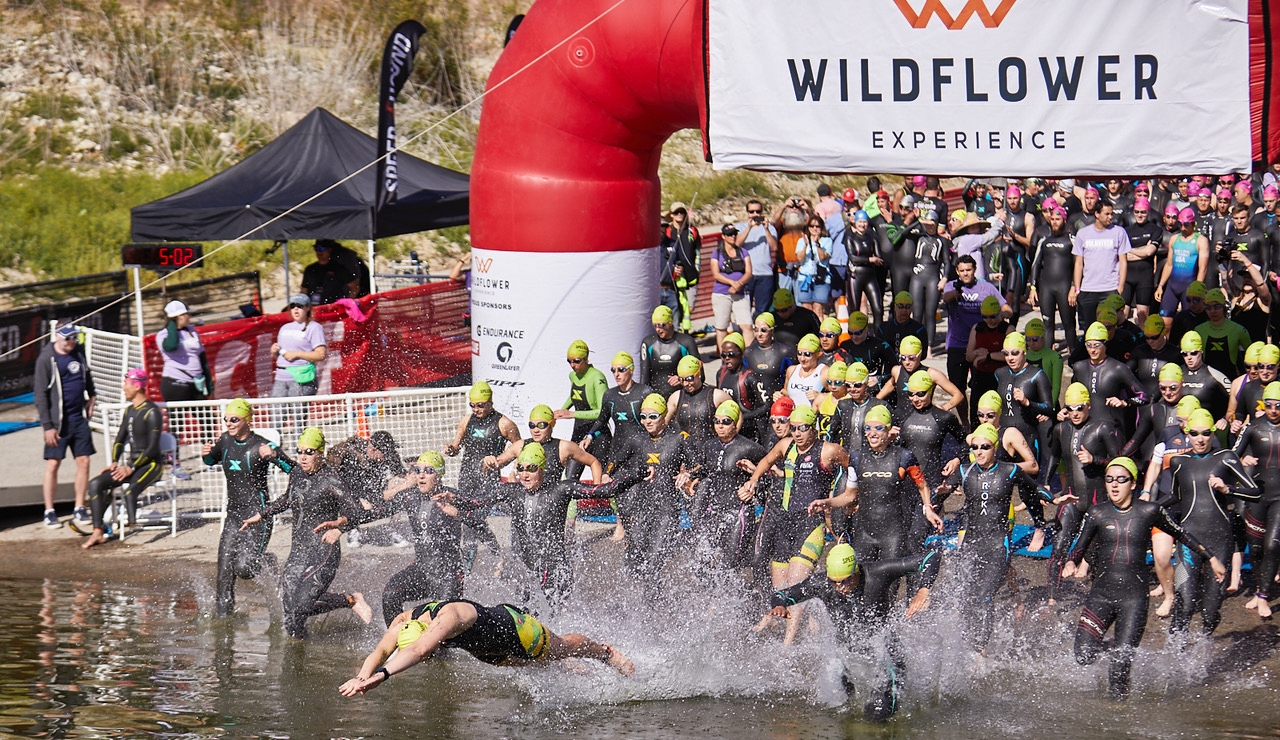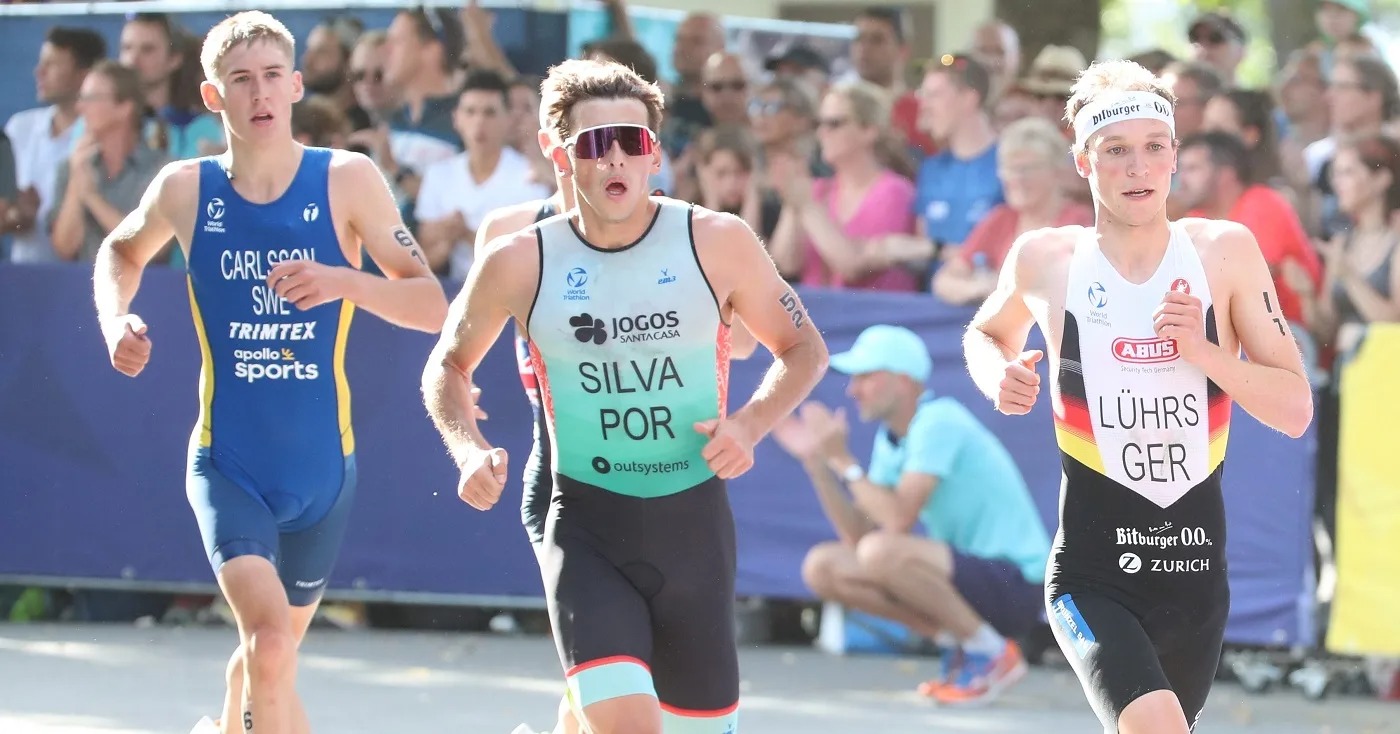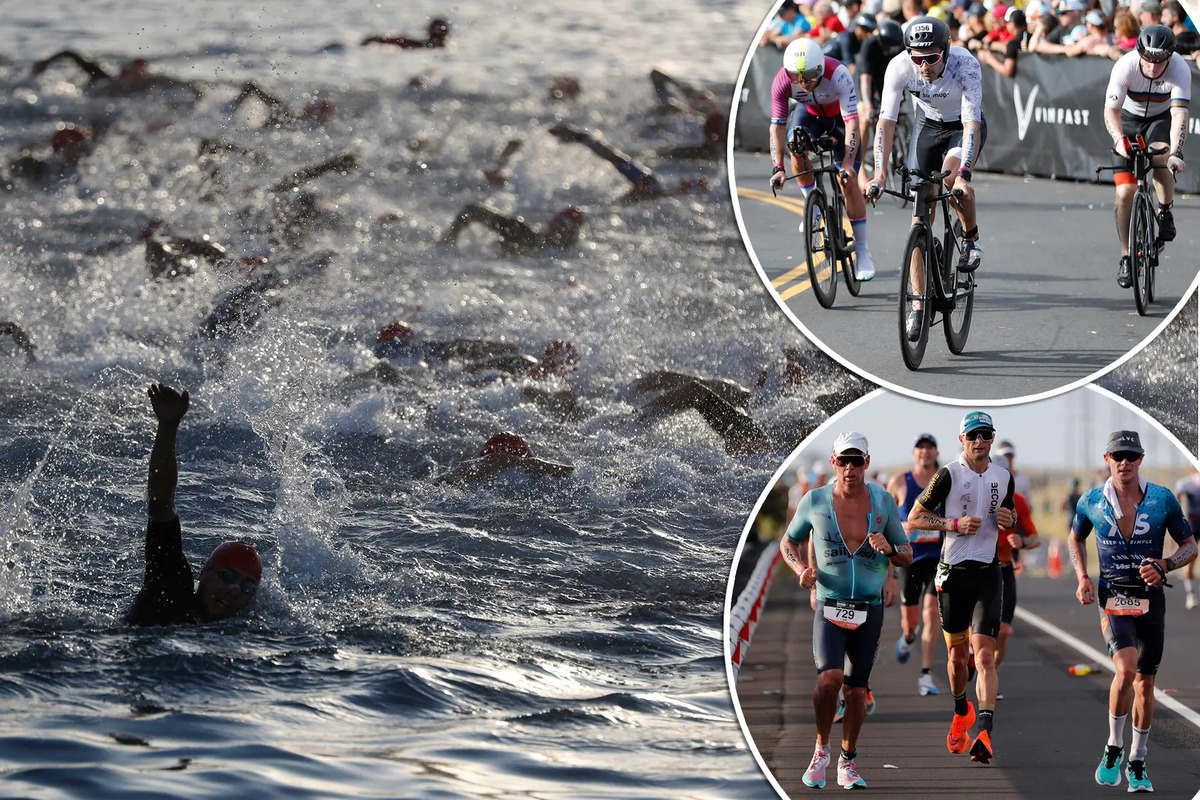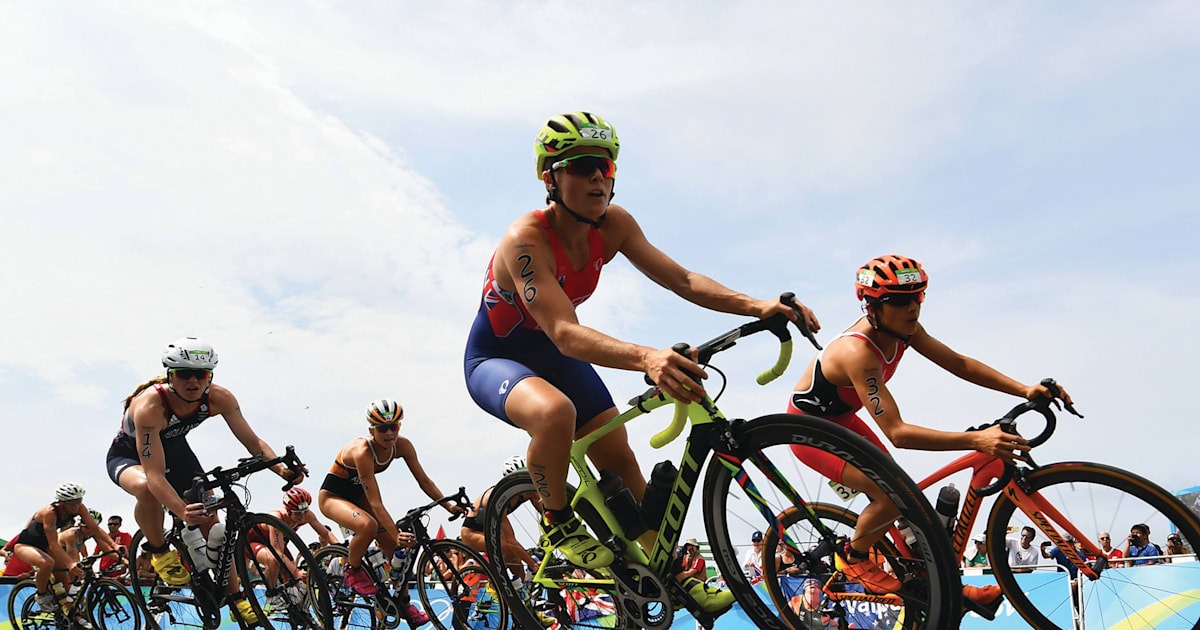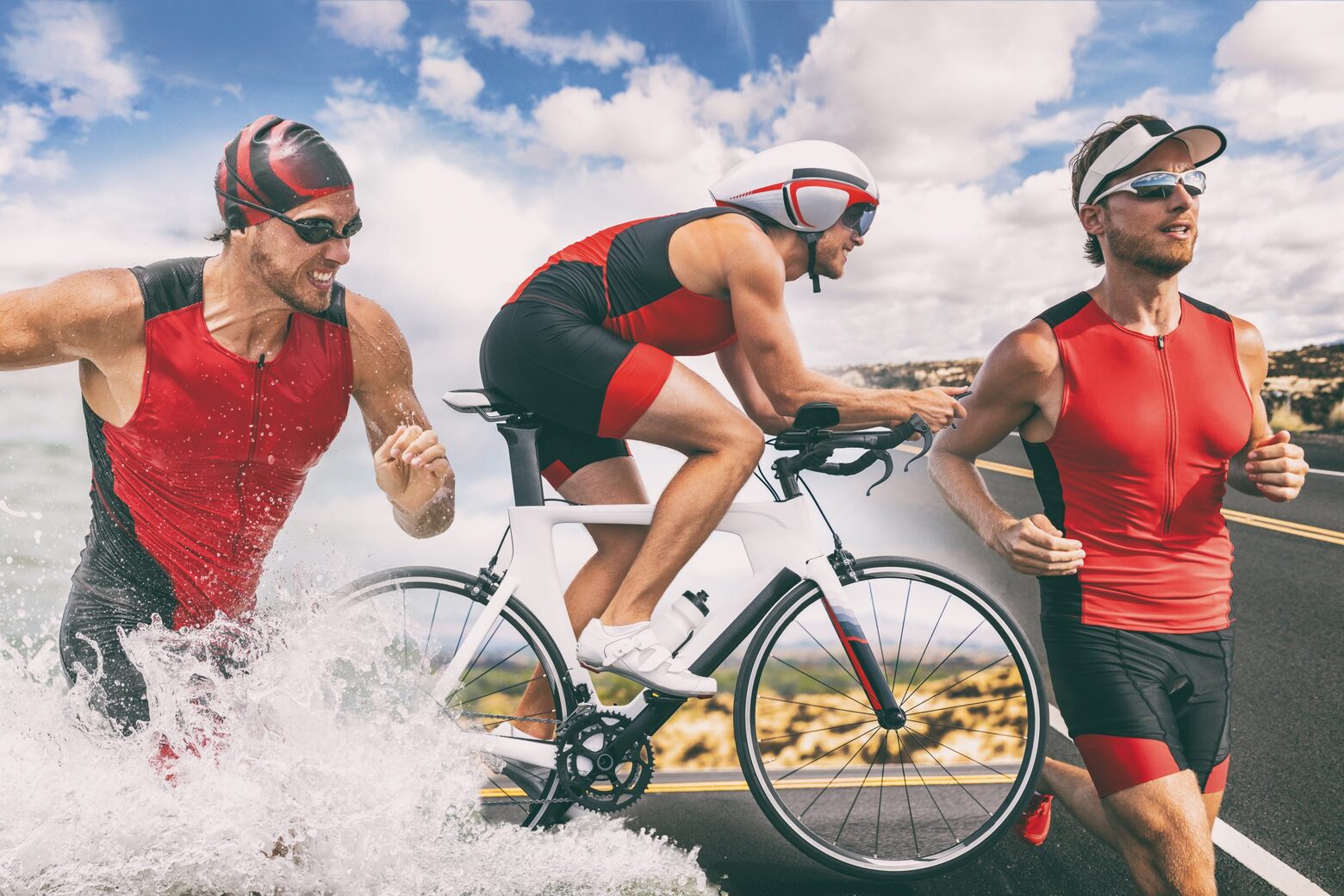

Featured
What Does Triathlon Consist Of
Modified: August 19, 2023
Discover the featured sport of triathlon - a challenging multisport event that combines swimming, cycling, and running. Learn about the ultimate test of endurance and athleticism.
Introduction
Welcome to the exhilarating world of triathlon, a multisport endurance event that pushes athletes to their limits both physically and mentally. Triathlon is a challenging and rewarding sport that combines swimming, cycling, and running into a single race. It requires a unique blend of strength, endurance, and mental resilience.
Triathlon attracts individuals of all fitness levels, from beginners looking to challenge themselves to seasoned athletes aiming to set new personal records. The sport has gained immense popularity worldwide, with thousands of people participating in triathlon events each year.
What sets triathlon apart from other endurance sports is the variety of disciplines involved. The race begins with a swimming leg, followed by a cycling leg, and concludes with a running leg. Transition areas between each leg play a crucial role, as athletes must efficiently switch between disciplines.
Triathlon offers a sense of camaraderie and community among athletes. It’s not just about competing against others but also about pushing oneself to overcome individual limits and achieve personal goals. Whether you’re aiming to complete your first triathlon or seeking to improve your performance, this article will equip you with the necessary information and insights to navigate the world of triathlon.
Throughout this article, we will delve deeper into the various components of triathlon, including swimming, cycling, running, transition areas, training, equipment, nutrition, and different triathlon distances. Moreover, we will provide useful tips and recommendations for beginners to help them kick-start their triathlon journey.
So, if you’re ready to dive into the exciting world of triathlon, let’s begin our exploration of this thrilling sport and discover what it takes to thrive in the world of multisport endurance racing!
Swimming
Swimming is the first leg of a triathlon and often considered the most daunting for beginners. However, with practice and proper technique, it can become a strength for athletes. Swimming in open water, such as lakes or oceans, adds an additional challenge compared to pool swimming due to factors like currents, waves, and lack of lane lines.
Proper technique is crucial in swimming to conserve energy and maintain a steady pace. Developing a strong and efficient swim stroke, such as freestyle or front crawl, is essential. It involves a rhythmic arm stroke, kicking from the hips, and proper body positioning to minimize drag in the water. Working with a swim coach or joining a masters swim program can greatly improve technique and overall swimming performance.
In triathlons, swimming can be a chaotic experience, with many athletes starting at the same time. It’s important to familiarize yourself with open water swimming and practice navigating through the water with a crowded field. Developing the skills to sight effectively (lifting your head out of the water to look ahead) is crucial for staying on course during open water swimming.
Training for the swim leg of a triathlon involves building both speed and endurance. Interval training, including sets of shorter, faster swims with rest in between, helps develop speed, while longer continuous swims build endurance. Incorporating drills such as kicking, pulling, and bilateral breathing can also enhance swimming technique and efficiency.
Investing in the right swim gear can greatly improve your performance. A well-fitted wetsuit provides buoyancy and insulation in colder water, while goggles with a comfortable and clear view are essential for visibility. Swim caps are often mandatory in races to ensure visibility and safety.
For beginners, it’s recommended to start with shorter swim distances and gradually work up to longer distances. Training in open water at least a few times before race day can provide valuable experience and help manage any anxiety or apprehension.
Overall, swimming is an integral part of triathlon and can be a challenging but rewarding discipline. With proper training, technique improvement, and confidence-building in open water, you’ll be well on your way to mastering the swim leg of a triathlon.
Cycling
Cycling is the second leg of a triathlon and often regarded as the longest and most physically demanding. It requires a combination of endurance, leg strength, and cycling skills to excel in this discipline.
One of the key factors in cycling is having a well-maintained and properly fitting bike. It’s important to choose a bike that suits your body size and riding style. Road bikes, with their lightweight frames and narrow tires, are popular among triathletes due to their efficiency on paved surfaces. Triathlon-specific bikes, with aerodynamic designs and integrated handlebars, are also common for those seeking maximum performance.
Training for the cycling leg of a triathlon involves building both cardiovascular endurance and leg strength. Long rides at a steady pace help develop endurance, while interval workouts with higher intensity intervals and recovery periods improve speed and power. It’s important to gradually increase the duration and intensity of your rides to avoid overtraining and reduce the risk of injury.
Cycling skills play a vital role in triathlon. Practicing efficient pedaling techniques, such as maintaining a smooth cadence and efficient gear shifting, can make a significant difference in your overall performance. It’s also important to practice cornering, descending, and riding in aero position (if applicable) to optimize speed and control on race day.
During a triathlon, nutrition and hydration are crucial for maintaining energy levels and performance on the bike. Training your body to consume fluids and fuel, such as energy gels or bars, while riding is essential. Experimenting with different nutrition strategies during training will help you determine what works best for you on race day.
In terms of safety, it’s important to follow traffic rules and wear appropriate cycling gear, including a helmet. Practicing bike handling skills and riding in a variety of road conditions can help improve your confidence and safety on the bike course.
On race day, the transition from the swim to the bike leg, known as T1, is a critical period. Efficiently changing from a wetsuit to cycling gear and getting on the bike quickly can save valuable time. Practicing transitions during training can help streamline the process and ensure a smoother race experience.
Cycling in a triathlon requires a combination of physical fitness, technical skills, and mental focus. With the right training and preparation, you can tackle the cycling leg of a triathlon and set yourself up for a successful overall race performance.
Running
Running is the final leg of a triathlon and plays a critical role in determining the overall performance and finish time. It requires a combination of endurance, speed, mental fortitude, and efficient running form.
Training for the run leg of a triathlon involves building both cardiovascular endurance and running-specific strength. Long runs at a steady pace help develop endurance, while interval workouts with shorter, faster runs interspersed with recovery periods improve speed and anaerobic capacity. Incorporating hill repeats and tempo runs can also enhance running strength and improve overall performance.
Technique and form play a crucial role in running efficiently. Key aspects to focus on include maintaining an upright posture, relaxed shoulders, and a slight forward lean from the ankles. Stride length and cadence are also important factors to consider. Aim for a comfortable cadence of around 180 steps per minute, which can help reduce the risk of injury and improve running efficiency.
Proper running shoes are essential for comfort, support, and injury prevention. It’s important to choose a pair of shoes that are specific to your running style and foot shape. Visit a specialty running store to receive expert advice and get fitted for the right pair of shoes.
Nutrition and hydration also play a vital role in the run leg of a triathlon. During training, practice fueling strategies to understand what works best for you. On race day, consuming carbohydrates and electrolytes at regular intervals can help maintain energy levels and prevent fatigue.
During a triathlon, transitioning from the bike to the run leg, known as T2, can be challenging. It’s important to practice quick and efficient transitions to minimize time spent changing from cycling to running gear. Setting up a well-organized transition area with your running shoes, socks, and any necessary nutrition can help streamline the process.
Mental strength and focus are key in the run leg, especially as fatigue sets in. Developing mental strategies, such as positive self-talk, breaking the run into smaller milestones, and visualization techniques can help maintain motivation and mental clarity during the race.
Lastly, pacing is crucial in the run leg to avoid burning out too early or finishing with energy left unused. Understanding your target race pace and practicing different pace intensities during training can help you develop a sense of pacing and optimize your performance on race day.
Running is often the most challenging leg of a triathlon, but it also offers a great opportunity to make up time and finish strong. With proper training, preparation, and mental fortitude, you can conquer the run leg and complete your triathlon on a high note.
Transition Areas
Transition areas are an integral part of triathlon races, as they serve as a hub where athletes transition from one discipline to another. There are two main transition areas in a triathlon, known as T1 and T2, which refer to the transitions from swimming to cycling and from cycling to running, respectively.
T1, also known as the swim-to-bike transition, is where athletes come out of the water and prepare for the cycling leg. It is typically located near the water’s edge or in close proximity to the swim exit. In T1, athletes need to quickly change from their swim gear, such as wetsuits and swim caps, to their cycling gear. This includes putting on a helmet, cycling shoes, and any additional gear, such as sunglasses or gloves. Organizing and laying out your gear in a systematic manner can help minimize transition time and ensure a smooth transition.
T2, also known as the bike-to-run transition, is where athletes finish the cycling leg and transition to the final running leg of the race. T2 is typically located near the bike dismount area and the start of the run course. In T2, athletes must quickly change from their cycling gear to their running gear. This involves removing the helmet, swapping cycling shoes for running shoes, and potentially grabbing any necessary nutrition or accessories. Similar to T1, a well-organized transition area can save valuable time and improve efficiency.
Efficient transitions are essential in triathlon, as they can significantly impact an athlete’s overall race time. Some tips for smooth transitions include:
- Practice transitions during training: Include transition practice in your training sessions to familiarize yourself with the process and identify areas of improvement.
- Organize your gear: Lay out your gear in a logical order, such as helmet, shoes, socks, and any additional accessories, so that it is easy to grab and put on quickly.
- Prep your shoes: Consider pre-tying your running shoes with elastic laces to make them easier to slip on without the need to tie them during the transition.
- Visualize the process: Mentally rehearse the transition process, picturing yourself smoothly moving from one discipline to another. This can help reduce stress and improve efficiency.
- Minimize distractions: Remove any unnecessary items from your transition area to avoid confusion and wasted time.
- Keep it simple: Stick to the essentials and avoid overpacking your transition area with unnecessary gear or accessories.
By practicing and strategizing your transitions, you can save valuable seconds and maintain momentum throughout the race. Remember, transitions are not just about changing gear; they are an opportunity to gain an edge over your competitors and make a seamless transition from one discipline to another.
Training
Training is an essential aspect of triathlon preparation, as it helps build the necessary fitness and skills required to excel in all three disciplines. A well-rounded training program should incorporate specific workouts for swimming, cycling, and running, as well as targeted sessions to improve overall endurance, strength, and flexibility.
When designing a training plan, it’s important to consider your current fitness level, time availability, and goals. Gradually increasing training volume and intensity over time allows your body to adapt and minimize the risk of overuse injuries. It’s advisable to consult with a coach or seek guidance from experienced triathletes to create a personalized training program that suits your needs.
To improve endurance, long workouts or steady-state sessions are important. These workouts help build cardiovascular fitness and teach your body to sustain effort over a longer period. For example, long runs, bike rides, and swim sets will gradually increase in duration as you progress in your training.
Interval training is another crucial component of triathlon training. This involves alternating high-intensity efforts with periods of recovery. Interval workouts improve speed, stamina, and anaerobic capacity. For example, a track session with sprint intervals followed by jogging recovery or hill repeats on the bike can help develop power and strength.
In addition to sport-specific training, it’s important to incorporate cross-training activities into your routine. Cross-training can help prevent overuse injuries, promote overall fitness, and maintain motivation. Activities such as strength training, yoga, Pilates, or swimming can provide a well-rounded fitness base while giving your body a break from the repetitive motions of swimming, cycling, and running.
Recovery is an essential part of any training program. Adequate rest days and proper sleep allow your body to repair and adapt to the training load. Listen to your body and take rest days or lighter workout days as needed to prevent burnout and injury.
Consistency is key in triathlon training. Regular and consistent training sessions will allow you to make progress and improve performance over time. A well-planned training schedule with varying intensities and recovery periods ensures a balanced approach.
Tracking your training progress can be helpful in assessing your fitness and identifying areas for improvement. Consider using a training diary or a fitness tracking app to record your workouts, track your progress, and monitor your performance throughout your training journey.
Remember to enjoy the process and stay motivated. Training for a triathlon is a long-term commitment that requires dedication and perseverance. Surround yourself with a supportive community of fellow triathletes or join a training group to stay motivated and share experiences.
By following a structured training program, incorporating cross-training, and prioritizing recovery, you’ll be well-prepared and confident to tackle the challenges of a triathlon and achieve your race-day goals.
Equipment
Having the right equipment is crucial for a successful and enjoyable triathlon experience. From swim gear to bikes and running shoes, each piece of equipment plays a vital role in your performance and comfort during the race. Here are some key equipment considerations for each discipline:
Swim:
- Swimsuit: Choose a swimsuit that is comfortable and allows for a full range of motion. Consider a one-piece or a well-fitting pair of swim trunks depending on personal preference.
- Swim Cap: Most triathlons require participants to wear a swim cap, which helps with visibility and identification in the water. Silicone caps are durable and provide a snug fit.
- Goggles: Find a pair of goggles that fit well and provide clear vision. Anti-fog lenses and adjustable straps are desirable features to consider.
- Wetsuit: In colder water, a wetsuit helps with buoyancy and insulation. Look for a wetsuit specifically designed for triathlon, with flexibility in the shoulders for ease of movement.
Cycling:
- Bike: Choose a bike that suits your riding style and budget. Road bikes are popular for their efficiency, while triathlon-specific bikes offer aerodynamic advantages. Ensure the bike is well-maintained and properly fitted to your body size.
- Helmet: Safety should be a top priority. Invest in a high-quality helmet that meets safety standards and provides a comfortable fit.
- Cycling Shoes and Pedals: Clipless cycling shoes and compatible pedals improve power transfer and pedaling efficiency. Practice clipping in and out of the pedals to become comfortable before race day.
- Clothing: Wear moisture-wicking, comfortable cycling clothing to enhance aerodynamics and keep you cool during the ride. Cycling shorts with padding can provide additional comfort on long rides.
- Tools and Spare Parts: Carry essential tools, spare tubes, and a mini pump or CO2 canister for emergency repairs during the race.
Running:
- Running Shoes: Invest in a good pair of running shoes that provide proper support and cushioning for your foot type. Consider getting professionally fitted at a specialty running store.
- Running Apparel: Choose moisture-wicking clothing that provides freedom of movement. Opt for lightweight and breathable materials.
- Hydration: Carry a handheld water bottle, a hydration belt, or use a hydration pack to ensure proper hydration during the run leg.
- Nutrition: Utilize a race belt or pocket in your running gear to carry energy gels or small snacks for sustaining energy levels.
Apart from discipline-specific equipment, other essential items to consider include a transition towel, sunglasses, sunscreen, and a race belt for attaching your race number. It’s also advisable to have a reliable sports watch or a timing device to keep track of your progress during the race.
Before race day, ensure that you have tested and become familiar with all your equipment to avoid any surprises or discomfort during the triathlon.
While having the right equipment is important, it’s equally essential to prioritize proper training, nutrition, and rest. Remember, it’s not just about the equipment you have, but how you utilize it to perform at your best.
Nutrition
Nutrition plays a vital role in triathlon performance. Fueling your body with the right nutrients before, during, and after the race can optimize energy levels, enhance endurance, and promote recovery. Here are some important nutrition considerations for triathlon:
Pre-Race Nutrition:
Proper pre-race nutrition ensures that you start the race with optimal energy stores. Aim to consume a balanced meal rich in carbohydrates, moderate in protein, and low in fat about 2-3 hours before the race. This allows enough time for digestion and reduces the risk of stomach discomfort. Some suitable pre-race meal options include oatmeal with fruits, toast with peanut butter, or a bagel with eggs.
It’s also important to stay hydrated before the race. Drink water or electrolyte drinks leading up to the event to ensure proper hydration. Avoid trying new or unfamiliar foods on race day to minimize the risk of digestive issues.
During the Race:
Proper nutrition and hydration during the race can help maintain energy levels and prevent fatigue. It’s crucial to develop a fueling strategy during training to understand what works best for your body. Consider these tips:
- Hydration: Drink water or sports drinks at regular intervals to stay hydrated. Sip fluids gradually rather than gulping large amounts all at once.
- Carbohydrate Intake: Consume easily digestible carbohydrates, such as energy gels, chews, or sports drinks, to provide a quick source of fuel. Aim for about 30-60 grams of carbohydrates per hour, depending on your body size and intensity of exercise.
- Electrolytes: Replace electrolytes lost through sweating by consuming electrolyte drinks or adding electrolyte tablets to your water. This helps maintain proper muscle function and hydration.
- Salt Intake: In longer races or hot conditions, consider adding salt capsules or salted snacks to balance sodium levels and prevent cramping.
Post-Race Nutrition:
What you eat after the race is crucial for recovery and replenishing energy stores. Aim to consume a meal or snack within 30-60 minutes of finishing the race. This meal should include a combination of carbohydrates to replenish glycogen stores, protein to aid in muscle repair, and fluids to rehydrate.
Some post-race meal options include a protein shake with fruits, a sandwich with lean protein, and a side of vegetables or a balanced meal with lean protein, whole grains, and vegetables. You can also consider consuming a recovery drink or snack specifically designed for post-workout recovery.
General Nutrition Tips:
- Balance and Variety: Maintain a well-balanced diet that includes a variety of fruits, vegetables, whole grains, lean proteins, and healthy fats to ensure you get all the necessary nutrients for optimal performance.
- Timing: Develop a regular eating schedule that works for you. Eat smaller, frequent meals or snacks every 2-3 hours to maintain energy levels throughout the day.
- Listen to Your Body: Pay attention to hunger and satiety cues. Eat when you’re hungry and stop when you’re comfortably full.
- Experiment and Refine: During training, try different nutrition strategies to determine what works best for your body and digestive system. Everyone is unique, so find what suits you best.
Remember, proper nutrition is a key component of optimal triathlon performance. By fueling your body with the right nutrients at the right times, you’ll have the energy and stamina to perform at your best during the race.
Triathlon Distances
Triathlons come in various distances, catering to athletes of different levels and abilities. Each distance offers a unique challenge, requiring different levels of fitness, endurance, and mental fortitude. Here are some of the most common triathlon distances:
Sprint Distance:
The sprint distance, also known as the “mini” triathlon, is an ideal starting point for beginners or those looking for a shorter, more manageable race. The distances for a sprint triathlon typically include a 750-meter swim, a 20-kilometer bike ride, and a 5-kilometer run. Sprint triathlons provide a great opportunity to test your skills and fitness without the overwhelming demands of longer distances.
Standard/Olympic Distance:
The standard or Olympic distance triathlon is the most commonly recognized and widely raced distance. It consists of a 1.5-kilometer swim, a 40-kilometer bike ride, and a 10-kilometer run. Olympic distance triathlons require a good level of fitness and training commitment, as the distances start to push the limits of endurance and speed.
Half Ironman (70.3) Distance:
The Half Ironman distance, also known as the 70.3, is a significant step up from the Olympic distance. It involves a 1.9-kilometer swim, a 90-kilometer bike ride, and a 21.1-kilometer run (half marathon). The Half Ironman is a popular choice for triathletes looking to challenge themselves before tackling the full Ironman distance.
Ironman Distance:
The Ironman distance is the epitome of endurance sports and is considered the ultimate test for triathletes. It consists of a 3.8-kilometer swim, a 180.2-kilometer bike ride, and a full marathon run of 42.2 kilometers. Completing an Ironman requires months of dedicated training, mental toughness, and a commitment to pushing personal limits. Ironman races often have strict time cutoffs to ensure athlete safety and maintain race organization.
Other Distances:
In addition to the aforementioned main distances, there are various other triathlon distances that cater to specific preferences and abilities. These include super-sprint triathlons, which are even shorter than sprints, and ultra-distance or long-course triathlons, which feature longer distances than the standard Ironman.
It’s important to choose a triathlon distance that aligns with your fitness level and goals. Beginners should start with shorter distances and gradually progress to longer races as they gain experience and fitness. Remember, the focus should be on personal accomplishment and enjoyment rather than comparing yourself to others.
Whichever triathlon distance you choose, it’s essential to have a well-rounded training plan that prepares you for the specific demands of the race. Train consistently, maintain good nutrition and hydration, and listen to your body to avoid overtraining and injury.
Regardless of the distance, participating in a triathlon is an incredible accomplishment. Each race distance provides a unique opportunity to challenge yourself, push your limits, and experience the joy of crossing the finish line.
Tips for Beginners
Embarking on your first triathlon can be both exciting and intimidating. Whether you’re a seasoned athlete in one discipline or completely new to multisport events, here are some valuable tips to help you navigate the world of triathlon and set yourself up for success:
1. Start with a Sprint Distance:
As a beginner, consider starting with a sprint distance triathlon. It’s a more manageable distance that allows you to get a taste of the sport without feeling overwhelmed. Sprint triathlons also provide a great learning experience to familiarize yourself with the transitions and race dynamics.
2. Invest in Proper Equipment:
While it’s not necessary to splurge on expensive gear, investing in quality equipment that suits your needs and fits you well can greatly enhance your comfort and performance. This includes a well-fitted swimsuit or wetsuit, a reliable bike, a comfortable helmet, and appropriate running shoes.
3. Seek Guidance and Expertise:
Consider working with a triathlon coach or joining a triathlon training group. Their expertise and guidance can help streamline your training, improve your performance, and provide valuable guidance on specific aspects of triathlon such as technique, training plans, and nutrition strategies.
4. Practice Transitions:
Transitions are a crucial aspect of a triathlon, and practicing them can shave off valuable seconds and reduce stress on race day. Set up a mock transition area during training to practice moving quickly and efficiently between disciplines.
5. Gradually Increase Training Volume:
Triathlon training requires a gradual increase in training volume and intensity to prevent overuse injuries and allow your body to adapt. Start with shorter training sessions and gradually increase the duration and intensity as your fitness improves.
6. Focus on Technique:
Technique is key in all three disciplines. Work on developing proper swim strokes, efficient cycling form, and a comfortable running stride. Seek guidance from experienced athletes or coaches to improve your technique and prevent injury.
7. Prioritize Nutrition and Hydration:
Pay attention to your nutrition and hydration needs during training and on race day. Fuel your body with a balanced diet, consume adequate carbohydrates, proteins, and healthy fats, and stay hydrated to optimize performance and recovery.
8. Celebrate Small Achievements:
Triathlon training can be challenging, but it’s important to celebrate every achievement along the way. Whether it’s completing your first open water swim or achieving a new personal best, acknowledge and reward your progress to stay motivated and inspired.
9. Don’t Neglect Recovery:
Allow your body time to rest and recover between training sessions. Incorporate rest days into your training plan and prioritize quality sleep. Recovery is essential for muscle repair, injury prevention, and overall performance improvement.
10. Enjoy the Journey:
Above all, remember to enjoy the process and have fun. Embrace the challenges, celebrate your progress, and savor the experience of participating in a triathlon. Surround yourself with a supportive community of fellow triathletes and cherish the camaraderie that comes with being part of this amazing sport.
By following these tips, you’ll be well on your way to a successful and rewarding triathlon experience. Embrace the journey, keep an open mind, and never stop pushing your limits!
Conclusion
Triathlon is a challenging and exhilarating sport that combines swimming, cycling, and running into one exciting event. From beginners to experienced athletes, triathlon offers a journey of personal growth, perseverance, and the thrill of crossing the finish line. Throughout this article, we have explored the various components of triathlon, including swimming, cycling, running, transition areas, training, equipment, nutrition, and different race distances.
Whether you’re just starting your triathlon journey or looking to take your skills to the next level, it’s important to approach the sport with dedication, patience, and a sense of adventure. Establishing a well-rounded training plan, seeking guidance from experts, and adopting smart nutrition and recovery strategies can help you achieve your goals and enjoy the process along the way.
Remember, triathlon isn’t just about the race itself; it’s about the personal growth and incredible sense of accomplishment that comes with pushing past your limits and achieving things you never thought possible. Embrace the challenges, celebrate your victories, and take pride in your journey as a triathlete.
As you embark on your triathlon adventure, remember to prioritize safety, listen to your body, and enjoy the camaraderie that comes with being part of the triathlon community. Whether you’re racing against others or simply competing with yourself, the sense of achievement and the unforgettable memories you will create are truly priceless.
So dive into the open water, hop on your bike, lace up your running shoes, and chase your triathlon dreams. The world of triathlon awaits, and with dedication, perseverance, and a can-do attitude, you’ll soon be crossing finish lines and embracing the incredible journey of a triathlete.

